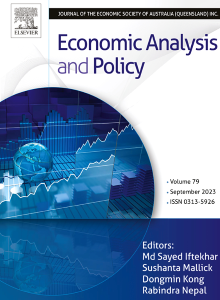What affects national innovative capacity? The role of economic growth and trade openness
IF 8.7
2区 经济学
Q1 ECONOMICS
引用次数: 0
Abstract
National innovative capacity (NIC) plays a crucial role in promoting the economic development of countries. This study analyzes the influential factors and heterogeneity characteristics of NIC in 82 countries using data from 2000 to 2020. The analysis of influencing factors using a fixed-effects model revealed that the innovative infrastructure, the innovative environment, and the link between innovative infrastructure and the environment can significantly enhance the NIC. Heterogeneity analysis using the finite mixture model (FMM) finds that 82 countries can be grouped into three groups, and the NIC in different groups have different development paths. The factors influencing NIC have a positive effect in most countries, although a small number of countries’ innovation capacity is constrained by factors such as R&D expenditure. The dynamic analysis results show that NIC development in many countries has seen a positive path shift with economic development and increased openness. This study not only identifies the key factors affecting NIC, but also analyzes in depth how trade openness and economic growth affect NIC, as well as the heterogeneous characteristics of NIC among different groups of countries. The findings reveal the differences in the paths of NIC enhancement among countries at different levels of development, providing a theoretical basis for the formulation of targeted policies. In addition, this study provides a new perspective on the dynamic evolution of NIC, which can be further expanded to a wider sample of countries or combined with finer-grained industrial data in the future to optimize the policy design of NIC enhancement, so as to promote sustainable innovation and economic growth on a global scale.
影响国家创新能力的因素是什么?经济增长和贸易开放的作用
国家创新能力在促进各国经济发展中起着至关重要的作用。本研究利用2000 - 2020年的数据,分析了82个国家网络收入的影响因素和异质性特征。利用固定效应模型对影响因素进行分析发现,创新基础设施、创新环境以及创新基础设施与环境之间的联系能够显著增强创新能力。利用有限混合模型(FMM)进行异质性分析发现,82个国家可分为三组,不同组的NIC发展路径不同。虽然少数国家的创新能力受到研发支出等因素的制约,但影响创新能力的因素在大多数国家都具有积极作用。动态分析结果表明,随着经济的发展和对外开放程度的提高,许多国家的互联网发展都出现了正向的路径转换。本研究不仅确定了影响NIC的关键因素,还深入分析了贸易开放和经济增长对NIC的影响,以及不同国家群体NIC的异质性特征。研究结果揭示了不同发展水平国家网络信息技术提升路径的差异,为制定针对性政策提供了理论依据。此外,本研究还提供了一个新的视角来研究NIC的动态演变,未来可以进一步扩展到更广泛的国家样本或结合更细粒度的产业数据来优化NIC增强的政策设计,从而促进全球范围内的可持续创新和经济增长。
本文章由计算机程序翻译,如有差异,请以英文原文为准。
求助全文
约1分钟内获得全文
求助全文
来源期刊

Economic Analysis and Policy
ECONOMICS-
CiteScore
9.80
自引率
9.20%
发文量
231
审稿时长
93 days
期刊介绍:
Economic Analysis and Policy (established 1970) publishes articles from all branches of economics with a particular focus on research, theoretical and applied, which has strong policy relevance. The journal also publishes survey articles and empirical replications on key policy issues. Authors are expected to highlight the main insights in a non-technical introduction and in the conclusion.
 求助内容:
求助内容: 应助结果提醒方式:
应助结果提醒方式:


